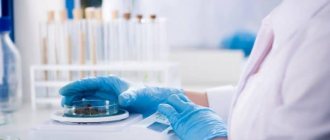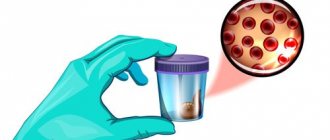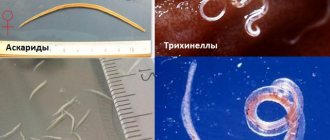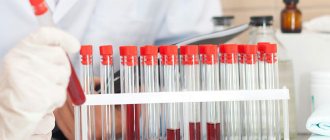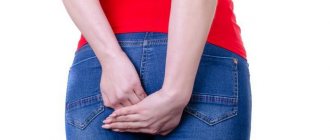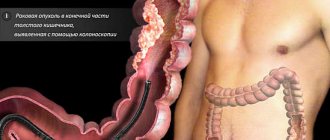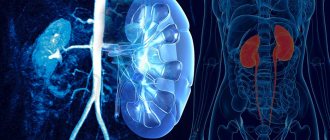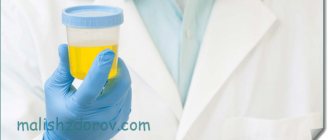Indications for the study
In pediatric practice, stool analysis is prescribed routinely:
- upon admission of a child to a preschool educational institution and school;
- during outbreaks of intestinal infections in children's educational and preschool institutions;
- for the purpose of preventing hidden infections;
- with diagnosed chronic gastrointestinal diseases.
Direct indications for checking stool are severe symptoms:
- failure of the emptying regime - diarrhea (diarrhea) or constipation (constipation);
- violation of the consistency, color and smell of excrement;
- the presence of foreign impurities in the stool (flakes, blood spots, purulent and mucous clots);
- abdominal pain;
- periodic nausea and vomiting.
In newborns, stool analysis is used to evaluate the enzymatic activity of the gastrointestinal tract if there are problems with digesting breast milk or artificial milk formulas (allergic reactions, colic). After a course of treatment for an intestinal infection, a follow-up study is required.
Features of preparation and collection of feces in children
Features of the study in children under one year of age:
- The diet of a breastfed or bottle-fed baby does not change.
- Feces are collected after washing the child with warm running water.
- The material can be collected from the diaper as long as it is not soaked in urine. Contact of feces should not be allowed with other physiological secretions.
For children over one year old, a pot can be used to collect material. The container must be pre-washed and dried.
The conditions for storing and delivering the material to the laboratory are no different.
Types of analyzes
Laboratory diagnosis of diseases of the digestive system includes several types of scatology. The most common is coprogram or general stool analysis. It evaluates the functioning of the gastrointestinal tract and related digestive organs.
Other tests often prescribed in pediatrics determine:
- worm eggs, lamblia and other parasites;
- enterobiasis (smear from the anorectal area);
- carbohydrates;
- intestinal group;
- disgroup;
- Gregersen reaction (occult blood).
The study is prescribed taking into account the suspected disease or disorder
Coprogram
Laboratory assessment of the chemical composition and physical properties of feces helps to identify violations:
Can stool samples be stored in the refrigerator?
- cavity and parietal digestion,
- absorption of nutrients in the small intestine;
- the process of formation of excrement in the colon;
- resorption (absorption) of fluid;
- functions of the pancreas and stomach, liver, spleen and biliary tract.
Analysis of stool for coprogram allows you to detect the presence of parasites, fermentation and rotting in the intestines. Options:
- Quantity.
- Chemical components: bile pigments (bilirubin, stercobilin), soluble protein (Vishnyakov-Triboulet test), acidity (PH).
- Macroscopy: shape, color, thickness (consistency). Determine the presence of blood, mucus, and pus in the excrement.
- Microscopy: red blood cells, epithelial cells, leukocytes, starch, fats, fatty acids, soap. The presence of ammonia, bacteria, yeast, helminth eggs, muscle fibers and undigested connective tissue, and digested fiber are detected.
The results obtained are interpreted by comparison with reference values for children of different age groups. A general analysis of feces in infants is differentiated depending on the type of feeding (artificial or breastfeeding).
Table of normal indicators of children's coprogram
| Breastfed babies | Parameter name | Artificial babies |
| 40-50 | daily amount in grams | 30-40 |
| sticky, viscous, viscous | thickness (consistency) | mushy |
| yellowish-greenish | color | tan |
| sour, sour | smell | ichorous (putrefactive) |
| 4,8-5,8 | RN | 6,7-7,4 |
| — | slime | — |
| — | blood | — |
| — | Vishnyakov-Triboulet test | — |
| + | stercobilin | + |
| + | bilirubin | + |
| — | ammonia | — |
| insignificant/absent | muscle fibers | insignificant/absent |
| — | connective tissue fibers | — |
| — | starch | — |
| — | cellulose | — |
| immaterial | fat | immaterial |
| single | fatty acid | single |
| a meager amount is determined | soap | a meager amount is determined |
| 10-11 | leukocytes | 10-11 |
| — | helminth eggs, worms, protozoan parasites | — |
| — | worms | — |
| — | red blood cells | — |
In a newborn baby, the indicators differ in the amount of feces - 19-21 g, and leukocytes - up to 15 units. Coprogram indicators are directly related to the nutritional characteristics, growth and development of the baby. The norms for children's values change after one year of age.
The amount of feces increases to 200-250 g. The excrement acquires a formed consistency. The color changes to a pronounced brown tint. The smell loses its sour and putrid harshness. Acidity increases slightly.
A good analysis shows the absence of bilirubin. Bile pigment in the body of newborns appears due to the breakdown of intrauterine hemoglobin and the body's transition to its own hemoglobin. Until 8-9 months, the presence of bilirubin is the norm. After 1 year it should not be there.
In older children, ammonia appears in the feces - from 20 to 40 mmol/kg and stercobilin - 200-350 mg/day. The number of leukocytes decreases to 8-9 units. Detailed decoding of the results is not provided. It is the responsibility of the pediatrician who referred for the study to decipher the analysis form.
What deviations may there be
| Color | |||||||
| black | white, colorless | red | green | bright yellow | |||
| internal bleeding | cirrhosis, hepatitis, bile duct obstruction | cracks and bleeding of the rectum, colon | typhoid fever | fermentation, impaired resorption in the intestine | |||
| Density | |||||||
| "sheep" feces | high density | pasty | foamy | liquid | |||
| varicose veins of the rectum (hemorrhoids) | chronic constipation, excess water absorption | pancreatitis | fermentation in the intestines | violation of peristalsis (contraction of the walls of the stomach, esophagus and intestines) | |||
| Smell | |||||||
| stinking, fetid | very sharp | ||||||
| putrefaction in the intestines | diarrhea caused by microflora disorders, infectious intestinal diseases | ||||||
| Impurities | |||||||
| pus | lientorrhea (pieces of undigested food) | yeast mushrooms | creatorrhoea (muscle fibers) | amilorrhea (starch) | |||
| severe inflammation, disintegration of tumor formations | chronic pancreatic diseases | intestinal candidiasis | enzyme deficiency | enzymatic deficiency, impaired peristalsis | |||
| Acidity | |||||||
| low | high | alkaline | high alkaline | ||||
| poor absorption of fatty acids | fermentation in the intestines | protein fermentation | rotting in the large intestine | ||||
| Leukocytosis (increased white blood cell count) | |||||||
| inflammation of the gastrointestinal tract (enteritis, colitis, ulcers, Crohn's disease). Malignant processes, intestinal tuberculosis | |||||||
| Soluble protein | |||||||
| dysbacteriosis (disturbance of the intestinal microenvironment) | |||||||
| Stecobilin is more than normal | |||||||
| spleen dysfunction, poisoning with toxins, drugs | |||||||
| Worms and protozoan parasites (giardia, balantidia, toxoplasma) | |||||||
| types of helminthiasis, giardiasis, balantidiasis, toxoplasmosis | |||||||
| Red blood cells | |||||||
| fissures of the rectum and colon, hemorrhoids | |||||||
If the obtained indicators do not correspond to laboratory standards, the child requires additional examination.
Tests for worm eggs and protozoan parasites
Determination of helminthic infestations and cysts (eggs) of protozoan parasites is carried out as part of a coprogram or prescribed separately according to indications. It is necessary to submit feces for analysis when a child develops a symptom complex of parasitic diseases.
If the study does not reveal cysts of protozoan parasites, but the child’s health is deteriorating, an ELISA (enzyme-linked immunosorbent assay) of the blood is prescribed for giardiasis, balantidiasis, toxoplasmosis, etc.
Types of helminth infestations determined during the research process
| Worms | Disease |
| toxocara | toxocariasis |
| roundworm | ascariasis |
| whipworm | trichocephalosis |
| liver flukes | opisthorchiasis |
| pork tapeworm | taeniasis |
| bull tapeworm | teniarinhoz |
| echinococcus | echinococcosis |
The final form indicates not only the type of pathogen, but also the number of parasites detected (per 1 cm3), their shape (larvae, adults, eggs).
Carbohydrate test
Analysis of stool for carbohydrates is prescribed to a newborn child to assess the degree of digestibility of milk sugar - lactose. The reference value for infants is 0.25%. Indicators from 0.7 to 1% indicate a predisposition to the development of lactase deficiency.
The baby is identified as a risk group, and the study is carried out several more times. If the result is consistently elevated, a course of treatment with enzymes is indicated. Values >1% indicate lactase deficiency of one of three types:
- primary or congenital – irreversible pathology;
- secondary, as a complication of a previous illness - is eliminated partially (sometimes completely);
- transient - eliminated without consequences.
Twice the norm is allowed in children under 3 months, due to the characteristics of the digestive system.
Analysis of stool for intestinal group
A method for diagnosing acute and chronic diseases of the digestive system of infectious origin. The laboratory evaluates the qualitative and quantitative composition of bacterial groups inhabiting the microflora of the colon. Normally, beneficial and opportunistic bacteria have a ratio of 90% to 10%.
For the study, the method of bacteriological inoculation is used - placing biomaterial (stool) on nutrient media favorable for the growth and reproduction of conditional pathogens. The measurement value is CFU (colony-forming unit). The highest incidence of pathogens is observed in the first days of infection.
Dynamics of bacterial growth in stool samples placed on a nutrient medium
Many opportunistic bacteria are resistant to antibiotics. Based on the results of bacterial culture, an antibiogram is performed - determining the resistance (resistance) of bacteria to antibiotics. This method allows you to select the most effective antibiotic therapy.
Norms of bacteria content in the intestinal microflora of infants under 1 year (in CFU)
| Name | Meaning |
| bifidobacteria | 1011 -1010 |
| bacteroides | 107-108 |
| lactobacilli | 106-107 |
| enterococci | 105-107 |
| eubacteria | 106-107 |
| clostridia | ≤103 |
| yeast fungi of the genus candida | ≤103 |
| staphylococci (saprophytic, epidermal) | ≤103 |
| peptococci | 105 |
Indicators for children from one year of age
Pathogenic (harmful) microorganisms such as salmonella and shigella should not be detected. Staphylococcus aureus should also not be detected.
Stool analysis for scatology
When people first encounter this term, they do not always understand coprogram - what is it? This analysis involves chemical, macroscopic and microscopic examination of stool. The test is based on a detailed analysis of chyme (food gruel), which makes its way through the gastrointestinal tract, and at the exit is formed into feces. During passage through the gastrointestinal tract, substances are broken down and absorbed, so it is possible to determine the functioning of internal organs from a person’s stool.
This is a description of what a coprogram is, but what do the results of this study indicate? Each deviation from the norm helps to identify the manifestation of a specific disease. The coprogram helps to identify dysfunctions of the secretory function of the stomach, pancreas, intestines, colitis of various etiologies, dysbacteriosis, and disruption of the absorption process. Reasons for performing stool microscopy may include:
- suspicion of intestinal parasitosis;
- assessment of prescribed therapy;
- acute, chronic pathologies of the duodenum, stomach, large and small intestines, liver, rectum, pancreas, gall bladder;
- Coproscopy is prescribed as part of a comprehensive preventive examination.
Preparation for delivery of biomaterial
Preliminary preparation helps to obtain objective results. Before a planned coprogram, avoid taking medications from the following pharmacological groups:
- laxatives (including dietary supplements);
- antibacterial and antifungal drugs;
- medications that increase gastrointestinal motility;
- natural and synthetic sorbents;
- iron-containing medications and dietary supplements.
On the eve of the coprogram, you cannot use rectal suppositories or perform an enema. It is necessary to obtain biomaterial naturally. An important point is changing your diet. From the menu you need to eliminate products that cause intense gas formation and affect the chemical composition, density and color of feces:
- cabbage, legume dishes, soda, rye bread;
- raw carrots, boiled beets, prunes, asparagus, greens, apples, liver.
Limit any sweets, baked goods, and fatty foods as much as possible. If the baby is breastfed, the woman must follow these rules. Infants are prohibited from introducing new complementary feeding components 3 days before stool delivery.
Dishes for collecting feces
In order to pass a stool test correctly, you need to prepare for the test.
Preparing for the study:
- do not perform an X-ray examination with a contrast agent, colonoscopy, gastroscopy for 7-10 days;
- 3 days before stool collection, do not take antibiotics; drugs affecting digestion; rectal suppositories;
- Avoid taking iron, bismuth, barium, castor or petrolatum oil.;
- 2 days before collecting the material, you should completely abandon tomatoes, tomato juice, pasta, beets and other vegetables and fruits containing dyes;
- food should consist of vegetables, fruits, cereals, fermented milk products, the amount of food should be within normal limits. It is necessary to refrain from fatty foods, smoked foods, spicy and pickled foods;
- bowel rinsing with enemas is prohibited;
- women are not recommended to take a stool test during menstruation;
- In young children, collecting feces from diapers is prohibited. To collect a stool sample, a diaper or oilcloth is used (if the stool is liquid).
Stool analysis. To ensure maximum accuracy and reliability of the results, it is necessary to strictly adhere to the established rules for preparing for the upcoming laboratory test.
General rules for preparing for analysis:
- last meal no earlier than 12 hours before testing;
- It is advisable to avoid taking medications unless there are specific instructions from the attending physician;
- it is necessary to warn the registrars of the OLIMP KDL about the medications you are taking;
- morning medication is taken only after the test;
- exclude alcohol intake 1 day before the test and do not smoke 2 hours before the test, also eliminate emotional stress on the eve of the test;
- upon arriving at the treatment room, it is not recommended to take tests immediately - you need to rest for 15-20 minutes;
- if repeated tests are planned, then for maximum reliability it is necessary to take them in the same laboratory at the same time of day.
There are general rules for preparing for stool donation.
Rules for preparing for stool donation:
- feces for examination are collected in a special sterile container with a screw cap and a spoon, which must be obtained in advance;
- 3-4 days before the study, it is necessary to stop taking laxatives, castor and vaseline oil, stop administering rectal suppositories and other drugs that affect digestion. Feces obtained after an enema, as well as after taking barium (during X-ray examination) are not used for research;
- Before collecting feces, women are advised to empty their bladder and first close the vagina with a cotton swab;
- feces are collected after spontaneous defecation in a bedpan. The bedpan must be clean; it is recommended to rinse it with running water several times and rinse it with boiling water. Next, the feces are collected with a spoon from 3-4 places of a single portion, placed in a disposable plastic container in an amount of no more than 1/3 of the container’s volume;
- Avoid introducing impurities into feces (urine, genital discharge).
Collection of biomaterial
It is recommended to submit biomaterial from morning stool for analysis. A container for feces can be purchased at a pharmacy. This is an airtight container with a special spoon. If a child has diarrhea, stool should be collected using a pipette.
To prevent debris, aerobic bacteria and other impurities from getting into the test sample, the children's potty should be washed and doused with boiling water. In infants, it is allowed to take biomaterial from the diaper, excluding the ingress of microparticles of hygienic material.
Fabric particles and fragrances with which they are impregnated can distort the results. Before emptying, perform hygiene of the anorectal area with warm water without soap (gel); the child can have a tummy massage. After defecation, collect feces with a spoon.
The laboratory will receive complete information if you provide fecal samples taken from 3 different sites for analysis. If blood, mucus and other inclusions are visually detected in the stool, fragments of them must be taken for examination. Seal the container tightly and immediately deliver to a medical facility.
A container with a spoon for stool analysis can be purchased at any pharmacy
Answers to frequently asked questions about coprogram
How much does a stool test for coprogram cost? The price depends on the region and the policies of private clinics; on average, a scatological examination in a good medical center will cost you 350-1000 rubles. In a public clinic, you can donate feces free of charge if you have relevant complaints and after presenting your compulsory health insurance policy;
How long to wait for the result? Medical institutions that provide services to the population on a commercial basis, as a rule, do this very quickly - they provide a transcript of the coprogram the very next day. After 1-3 days, laboratories at clinics transfer the finished analysis form directly to the doctor to whom the patient turned - usually a local therapist or pediatrician. Therefore, you will be able to find out the results of the study as soon as you attend your next appointment;
Is it possible to freeze and test yesterday's stool? Yes, this is completely acceptable. Everyone has their own biorhythms - there are people who habitually empty their bowels in the evenings, but in the morning they don’t really feel like going to the toilet at all. With young children, especially infants, coprogram sometimes becomes an impossible task if you try to collect fresh morning feces and immediately deliver it to the laboratory;
Is it necessary to donate stool in a special container? No, but it meets all hygienic requirements, is easy to use and inexpensive. Private clinics usually issue such containers along with a referral for coprogram; their price is included in the total cost of the service. And in a state laboratory they will take your stool in any suitable container - a small sealed jar made of plastic or glass, but they will ask if you washed it well;
How much feces should be submitted for coprogram? A volume approximately equal to one teaspoon is sufficient, but it is better to collect a sample from different parts of the stool, so that it becomes possible to evaluate the composition and properties of feces as objectively as possible. If you use a special container with a spoon, then scoop 3-5 servings from the top, side and middle of the feces;
Is it possible to do a coprogram during menstruation? It is not advisable, it is better to wait until the end of menstrual bleeding to be sure that blood will not get into the sample being studied and will not distort the decoding of the coprogram. If there are urgent indications or a threatening health condition, then a stool test can be taken, but during defecation it is necessary to securely close the entrance to the vagina with a hygienic tampon or sterile cotton wool;
Is it true that you can’t have anal sex before coprogram? Yes, this is true, and not all doctors, due to the sensitivity of this topic, warn patients about the need to temporarily refrain from such pleasures. During anal sex, bleeding injuries to the rectum may occur, and even if they are microscopic, deciphering the coprogram will give a false positive test result for occult blood;
Is what a coprogram shows always enough to make a correct diagnosis? No, this is a basic test that allows you to suspect a problem and outline a further examination strategy. Very often, based on the results of scatology, the patient is referred for bacteriological analysis of stool, ultrasound of the abdominal organs, X-ray contrast tomography, colonoscopy, sigmoidoscopy and other diagnostic procedures.
Summary of the article
The coprogram is an advanced analysis of feces and an assessment of their physical and chemical characteristics. Typically, a coprogram is prescribed to young children if doctors suspect problems with digestion or the gastrointestinal tract. A stool coprogram will not be informative if the doctor suspects an infection in the stomach - for this it is necessary to do a bacteriological culture of the stool. However, the coprogram is an important, productive study of organs such as the liver, pancreas, stomach and intestines.
Storage conditions for biological material
How much biomaterial is needed for research, and how long can it be stored? To conduct a qualitative analysis, 15-20 g of biomaterial is sufficient. When testing for the intestinal group, the sample can be stored for no more than 3 hours.
Long-term storage makes excrement unusable, since many bacteria die upon contact with air. The result will be false. For coprograms, evening stool can be collected. The container should be sealed and stored in the refrigerator until the morning.
Important! The biomaterial sample must not be frozen or exposed to heat.
Failure to comply with the rules of preparation, conditions for collecting and storing excrement, the indicators will be biased. The pediatrician will not be able to choose the right treatment tactics.
Coprogram indicators
In children and adults, when examining stool, the following indicators are determined:
- muscle fibers - the remains of meat food;
- connective tissue is a substance of animal origin;
- neutral fat – residues of fat-containing products;
- fatty acids – products of digestion of dietary fats;
- plant fiber – digestible and indigestible cell membranes of plant tissues;
- starch - found in plant products, but normally completely broken down by pancreatic enzymes;
- epithelial (surface) cells of the intestine and mucus secreted by the glands of the intestinal wall during inflammation;
- leukocytes - immune cells that accumulate at the site of inflammation;
- erythrocytes – the main blood cells;
- stercobilin - the product of the final neutralization of bilirubin that enters the intestinal lumen with bile, has a brown color, causing the color of feces;
- bilirubin is a substance formed in the liver and excreted through the bile ducts into the intestines;
- iodophilic flora - microorganisms that are stained with special dyes and cause fermentation in the intestines;
- protozoa, fungi, worm eggs are signs of parasite infection.
Normal coprogram indicators in children and adults
| Index | Norm | ||||
| In adults | In children | ||||
| Under 1 year | Over 1 year old | ||||
| Acidity (pH) | 6,0 – 8,0 | 4.8 – 6.0, with artificial feeding – up to 7.5 | 7,0 – 7,5 | ||
| Muscle fibers | No or isolated | There may be some undigested | None or individual overcooked | ||
| Connective tissue | No | ||||
| Neutral fat | No | In small quantities | No | ||
| Fatty acid | No, there may be a small amount of fatty acid salts | In small quantities | No | ||
| Plant fiber | Indigestible can be in different quantities depending on the volume of plant food; digestible – single cells or their clusters | ||||
| Starch | No | In small quantities | No | ||
| Epithelium | No, single columnar epithelial cells are acceptable | No | |||
| Slime | No | ||||
| Leukocytes | No or single neutrophilic leukocytes | ||||
| Red blood cells | No | ||||
| Stercobilin | The reaction is positive | ||||
| Bilirubin | No | Eat | No | ||
| Iodophilic flora | No or single cells | ||||
| Protozoa, mushrooms, worm eggs | No | ||||
When quantitatively measuring chemical indicators, the standards are as follows:
- stercobilin 200–600 mg/day (according to Adler) or 30–100 mg/day (according to Terven);
- the ratio of urobilin and stercobilin (Adler coefficient) from 1:10 to 1:30;
- total nitrogen 2 – 2.5 n/day;
- sucrose – up to 300 U/g;
- trypsin – up to 670 U/g;
- lipase – up to 200 U/g;
- amylase – up to 600 U/g;
- enterokinase – up to 20 U/g;
- alkaline phosphatase – up to 150 U/g;
- trypsin 80 – 742 g/day;
- chymotrypsin 75 – 839 g/day.
Decoding the results of scatological research
When the results are ready, the person will receive a form indicating normal indicators and the results obtained from the study of the material. It is better to consult a doctor for a decoding, since even a deviation from the norm of several indicators does not always indicate the presence of pathologies.
Normally, an adult's feces should be uniformly brown in color, dense, and have a characteristic odor. The feces of a healthy person are free of foreign impurities, food debris, protozoa and parasite eggs. The presence of undigested fiber in the stool indicates low acidity of gastric juice, the presence of blood and pus indicates serious gastrointestinal pathologies.
When is a study prescribed, and what is its essence?
Stool analysis is considered one of the most important tools for assessing the functionality of the intestines, liver, pancreas and gall bladder, allowing a preliminary diagnosis to be made for the patient. Like a clinical urine test, coproscopy provides a detailed physical characteristic (by appearance), and also allows you to determine the microscopic and chemical composition of the biomaterial under study using special reagents. Scatology is a way to detect bacteria and occult blood that are not visible to the human eye.
A general stool analysis is rarely prescribed to a patient as a separate study and often acts as an additional, but extremely informative diagnostic tool. He is appointed:
- during preventive examinations of children and adults in the clinic (dispensary examination);
- if you suspect dysbiosis and irritable bowel syndrome (IBS);
- in case of malabsorption (celiac disease, ulcerative colitis, malabsorption);
- in the complex diagnosis of secretory insufficiency and inflammation of the upper gastrointestinal tract (duodenitis, GERD, gastritis);
- for acute and chronic hemorrhoids, rectal hernia;
- in the diagnosis of genetic pathologies, oncology, HIV infection.
A coprogram is also a way to detect the antigen of rotavirus infection in the event of infection with it. In addition to the above, the study allows you to learn about the effectiveness of the prescribed treatment for gastrointestinal diseases.
Coprogram indicators
Scatological analysis includes macroscopic indicators of the resulting sample: volume, consistency, smell, shade, nature of possible impurities. Biochemical examination reveals pigments, protein structures, fats and hemoglobin. Stool microscopy determines the presence of leukocytes, red blood cells, fibers and crystals.
To decipher the data received from the laboratory, you can use the summary table below. Typically, a coprogram includes a number of indicators and looks like this:
| Standards for adults | |
| Consistency | Dense |
| Form | Decorated |
| Color | Brown |
| Smell | Fecal, unsharp |
| pH (acidity) | 6.0–8.0 (neutral, slightly acidic, slightly alkaline) |
| Slime | A small amount of |
| Blood | (–) |
| Undigested foods | (–) |
| Reaction to stercobilin | Positive |
| Bilirubin, ammonia | (–) |
| Protein | (–) |
| Reaction to occult blood | Negative |
| Protein fibers with striations | (–) |
| Protein fibers without striations | (–) |
| Connective fibers | (–) |
| Neutral fats, fatty acids and their salts | (–) |
| Digestible fiber | Single |
| Starch (intra- and extracellular) | (–) |
| Pathological impurities | (–) |
| Soap | In small quantities |
| Eosinophils | (–) |
| Leukocytes | Single |
| Red blood cells | Single |
| Epithelial cells | Single |
| Crystals (tripelphosphates, cholesterol, uric acid, hematoidin, Charcot-Leyden) | (–) |
| Hemoglobin, haptoglobin | (–) |
| Detritus | Available in varying amounts |
| Salts (oxalates) | None |
Reasons for deviation from the norm
Feces are formed from the remains of the bolus of food in the large intestine. It consists of detritus, dietary fiber, epithelium, water, bile and enzymes. Their number and type depend on nutrition and other factors.
By analyzing all the research data obtained, the doctor will determine in which part of the intestine the pathological changes occurred and whether there is an enzyme deficiency.
Macroscopic indicators
Thick, dense-textured stool is considered normal. This indicates a sufficient amount of liquid in it. When plant foods with a high fiber content predominate in the diet, intestinal motility increases, and feces take on a mushy form. If an increase in the frequency of bowel movements is noted with liquid stool, then they speak of diarrhea (diarrhea).
Hard stools are a consequence of slow peristalsis and dehydration of feces. This condition occurs with constipation or hemorrhoids. These disorders appear due to poor nutrition, as well as in men with prostatitis, in women during pregnancy and after childbirth.
The smell of feces changes with the abuse of protein foods. Fetid occurs during putrefactive processes in the lower intestines, with cholecystitis or pancreatitis. The sour smell is the result of fermentation.
The color of the stool is determined by a pigment called stercobilin, and changes depending on the diet and the use of iron-containing drugs (for example, Maltofer). Colorless stool indicates a violation of the outflow of bile due to stones in the biliary tract (often with cholelithiasis), occurs with cirrhosis of the liver, jaundice. With hepatitis A and C, the level of pigment also decreases. A light color is possible when taking antibiotics or consuming fatty foods, as well as in pregnant women due to increased stress on the digestive organs.
Too dark stool is due to excess stercobilin. Dark brown occurs with pleiochromia (high content of bile pigments in bile). Black feces can appear after taking certain medications, in particular De-Nol.
Biochemical indicators
A pH level below normal with an acidic reaction occurs due to problems with the metabolism of fatty acids, as well as an increase in fermentation microflora. The increase in pH (alkaline reaction) is due to the large amount of meat protein in the diet. In this case, rotting of the protein elements occurs. A sharply alkaline reaction is characteristic of putrefactive dyspepsia.
Fatty acids should not be observed in the stool. In a healthy person, they are absorbed by the body. If the number of fats is several times higher than the reference values, then steatorrhea is diagnosed. As a rule, it is observed in cases of problems with the flow of bile, such as cystic fibrosis. Soaps in the coprogram speak of pancreatic dysfunction.
The detected native protein means the development of inflammation in the upper part of the gastrointestinal tract (colitis, enteritis, gastroduodenitis, duodenal ulcer, gastric ulcer, cancer). Be sure to take into account the presence of symptoms. If a person experiences pain in the hypochondrium and bloating, then increased protein indicates acute pancreatitis.
Normally, only altered muscle fibers are detected. If a scatological examination shows unchanged muscle fibers, the gastroenterologist will prescribe an additional examination of the pancreas, since this indicator indicates problems with the breakdown of proteins.
Microscopic indicators
Red blood cells in the stool indicate inflammatory processes in the digestive tract or damage to it by tumors. Moving through the intestines, fecal lumps injure the inflamed areas, causing bleeding of varying intensity. Another reason why stool contains blood cells may be helminthic infestation. If occult blood is detected, its quantity will be determined as + for a weakly positive reaction, ++ for a positive reaction.
Mucus is produced by the intestinal epithelium as a protective reaction to irritating factors. In the event of inflammation of an infectious or non-infectious nature, the amount of mucus increases. This occurs, for example, with intestinal tuberculosis, cholera, ulcerative colitis, IBS or Crohn's disease. Bacteria that can cause fermentation in the intestines (dyspepsia) form iodophilic flora. Their determination is made using an iodine test: pathogenic organisms differ in the resulting color.
Extracellular starch indicates a decrease in the function of specific enzymes (amylase) that are responsible for its breakdown. Leukocytes and macrophages indicate the presence of any inflammation in the gastrointestinal tract, including those found in large numbers during acute intestinal infection (AIE).
How to collect stool
It is better to collect stool from an adult and a child in the morning, immediately after the morning toilet, and try to deliver it to the laboratory as quickly as possible. You need to collect material from different parts of the feces, put them in sterile containers, or special disposable plastic containers, which can be purchased at the pharmacy. Evacuation should be natural; the use of laxatives, much less enemas, is prohibited.
In infants, it is not recommended to collect feces from the diaper; it is better to use a disposable diaper or medical oilcloth if the child has loose stools.
You can collect baby feces directly from the diaper
An older child needs to prepare a potty; first wash it with laundry soap or soda.
How much feces do you need?
To carry out the analysis, you need to bring 15–20 g of material to the laboratory, which is approximately equal to 1 tsp. – this amount is quite enough to identify all the main indicators.
Is it possible to collect stool samples in the evening?
It is better to use a morning portion of feces for analysis, but if you are not sure that defecation will occur after waking up, you can collect the material in the evening; it should be stored in the refrigerator for no more than 10–12 hours, the container should be hermetically sealed.
You can store stool for analysis in the refrigerator for no more than 12 hours.
